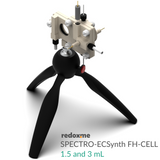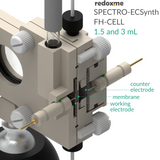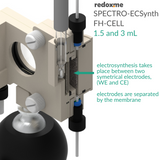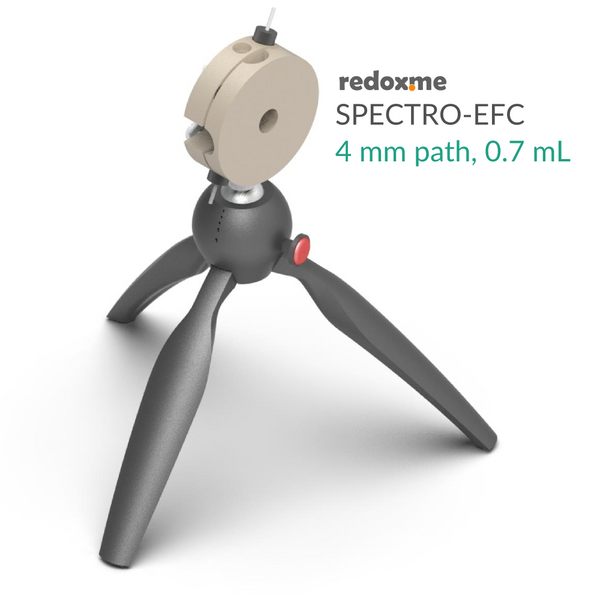SPECTRO-ECSynth FH-CELL 1.5 and 3 mL - Spectro-Electrosynthesis Flow H-Cell 1.5 and 3 mL

This is a horizontally mounted, double compartment Spectro-Electrosynthesis Flow H-Cell used for real-time investigation of compounds synthesized via electrochemical reaction (i.e. electrogenerated products). The Cell is compatible with several spectral techniques including UV-Vis (quartz windows), NIR and IR (CaF2 windows) as well as Ultrafast Laser Spectroscopy (CaF2 windows). The main advantages include a short distance between electrodes (no need of supporting electrolyte), excellent yields due to the high-surface-to-volume ratio of the electrodes (high conversion efficiency) and short reaction time.
The cell elements are made of PEEK. It well fits aqueous (EPDM/FKM O-Rings) and organic solvent (FFKM O-Rings) electrolyte requirements. The construction is liquid-tight having two separate chambers, each equipped with electrolyte inlet and outlet. The Working Electrode (WE) compartment is a flow cell with a continuous and efficient electrolyte withdrawal from the WE volume (in case of porous WE) and surrounding. This allows solutions flow and evacuation of reaction products into the detection area. The Counter Electrode (CE) compartment is a static chamber filled up with an electrolyte before an experiment. However, continuous flow of an electrolyte in CE compartment is also possible. Chambers are separated with a membrane, so the electrochemical products appearing at CE do not mix with products created at WE. There is a broad range of membranes for both aqueous and organic electrolytes. This way only products from WE are being transferred into a detection zone. However, the membrane may be removed which transforms the cell in a single compartment reactor. The cell is compatible with various types of electrodes including Rhodium-plated Counter Electrodes, Platinum and Gold Metal Wire Electrodes (various shapes and forms).
Application note
This cell has been designed for real-time investigation of electro-synthesized compounds. In the standard configuration the WE and CE electrodes are symmetrical and mounted in separate compartments with a membrane in between them. However, these electrodes can be customized on request (shape, size, form and material). The thickness of the electrolyte in the detection area is set by one of three spacers with thicknesses of 0.3 mm, 0.5 mm and 1 mm. A classical Reference Electrode (RE) is mounted in the flow WE compartment. The WE compartment should be connected with an external reservoir to circulate the solvent using peristaltic pumps. This reservoir may be equipped with additional electrodes (e.g. pH meter probes) and the exhaust gases may be supplied to gas analysis (e.g. Gas Chromatography). A gas purging (via mass flow controller) and ice cooling may also be applied. The electrode potentials and volumetric flow rate need to be optimized to achieve desirable conversion and yield in a single pass. Regulation of the flow rate enables control over reactive intermediates, leading to a higher selectivity. Typical applications include: electrosynthesis, electro-oxidation and electrofluorination. For troubleshooting instruction see the redox.me blog post.
Specification
WE flow compartment volume: 1.5 mL
CE compartment volume: 3 mL
electrode plug diameter: 6 mm
Tubing ID for WE compartment: 3 mm
Tubing ID for CE compartment: 1 mm
standard electrodes: Rhodium plated CE model 7
Intrastat data
HS Code: 90275000
Country of Origin: Sweden
NET weight: 200g
Product includes
1 x WE flow chamber
1 x CE chamber
1 x window/membrane holder
3 x spacer (0.3 mm, 0.5 mm and 1 mm)
1 x CE chamber lid
1 x WE electrode (customized Rh-plated CE - model 7)
1 x CE electrode (customized Rh-plated CE - model 7)
1 x set of membranes (customizable)
2 x quartz window
2 x CaF2 window
2 x sapphire window
1 x Reference Electrode (Ag/AgCl or Ag/Ag+ 30 mm)
1 x table tripod – 0028PHYCM
1 x plug
1 x set of Nylon screws
Related products
Rhodium Plated Electrodes
Reference Electrodes
Membranes





















